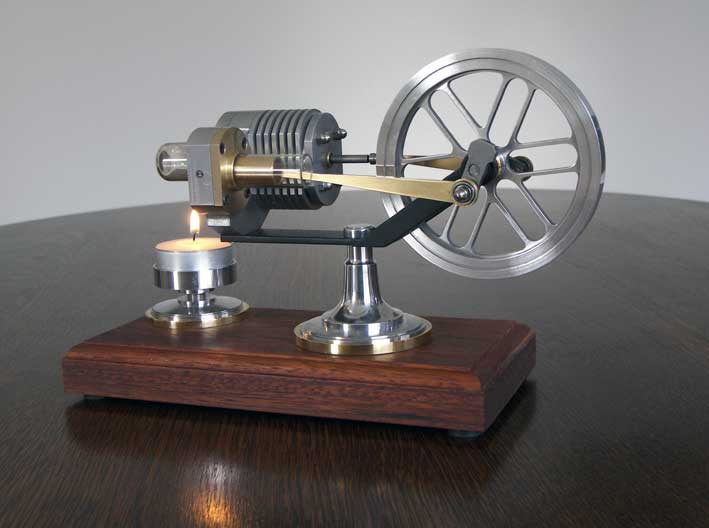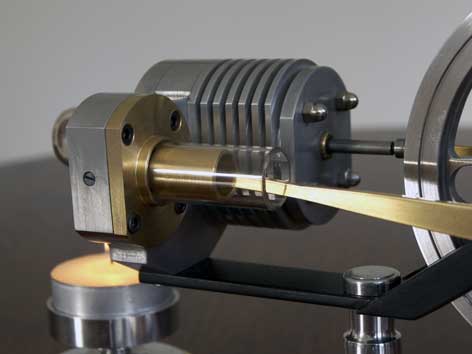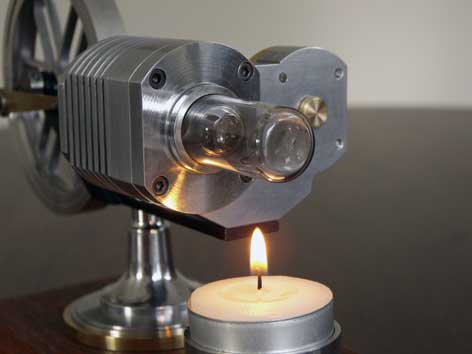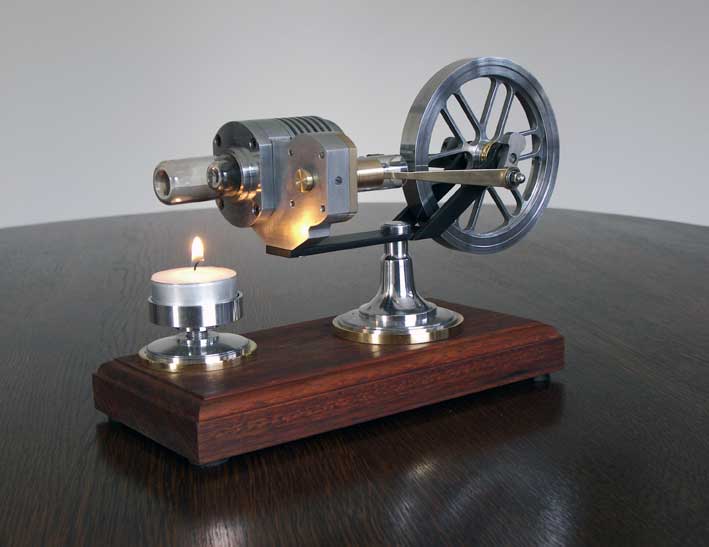The idea
This is one of my first model engines I made since my retirement in 2001. The basis for this design was a picture I saw in a Dutch magazine but I redesigned it thoroughly. I used a tea candle in stead of the spirits burner as with the original design and changed the cosmetic appearance also completely. I consider this kind model engines as pieces of jewelry that can be demonstrated in living room environments. In my opinion spirits burners don't fit in that because the danger of burning the table when you spill some spirits that easily can happen. Tea candles are much more safe and friendly to use in this environment; they burn for hours without any bad smell.
The energy of a tea candle flame is somewhat less than that of a spirits flame so I had to optimize the mechanical system in terms of frictions. I applied small ball bearings (without dust rings) on the fly wheel axis and on the big ends of the driving rods. To make them run as light as possible I washed them grease free with dry cleaning naphtha. Furthermore I paid a lot of attention to line-out the whole system a well as possible.
Some technical details and used materials.
Originally I made the working cylinder from brass with a steel piston in it, but recently (February 2010) I replaced this cylinder with a glass one with a brass piston in it; easier to make and no wearing at all without any oil. So now this engine has a glass hot cylinder, a glass displacer and a glass power cylinder. The result is a very clear and inside view on all engine movements with what the typical Stirling process is demonstrated nicely.
The glass cylinders and displacer are cut from standard pyrex glass test tubes that are heat resistant. Apart from the fact you can look through the glass it has the advantage of a very low heat conductance. That means that the glass temperature is about ambient some 2 to 3 cm from the very hot spot of the candle flame. That makes it possible to fix the hot cylinder simply with a rubber O-ring in the flange, mechanically and air-tight at the same time. For the same reason there is hardly any heat conductance to the aluminum cold cylinder which is important for the Stirling process.
The glass displacer is cemented with some silicone glue on a aluminum kernel with a screwed-in driving rod.
It is of most importance that the displacer driving rod moves with low friction but almost air-tight in the glide bush. Preferably use a standard axis and a standard glide bush for it because the quality is better than what you can make yourself most of the time.
Never oil the moving parts. There is no need for that and the oil viscosity only causes extra frictions. It is my experience that with oil lubricating this kind of low power Stirlings run bad or not at all, how thin the oil is!
The tea candle is placed in a holder with a threaded spindle so the height of it can be varied and, with that, the temperature of the hot cylinder. With this adjustment the speed of the engine can be regulated between about 100 and 600 rpm.
Video:
Main dimensions
Outlines l*w*h= 250*100*160 mm;
Diameter glass hot cylinder: outer 19,5mm, inner 17mm;
Diameter glass displacer: outer 15,5 mm, inner 13,5mm; stroke 20mm;
Diameter glass working cylinder: outer 15,5mm, inner 13,5mm;
Diameter glass working piston: outer 15,5mm, inner 13,5mm; stroke 20mm;
Diameter aluminium vliegwiel: 100mm; breedte 12 mm.
Drawing plan
A request for the CAD drawing plan can be done via the page of the improved version Sterling Stirling Bas; click here .



